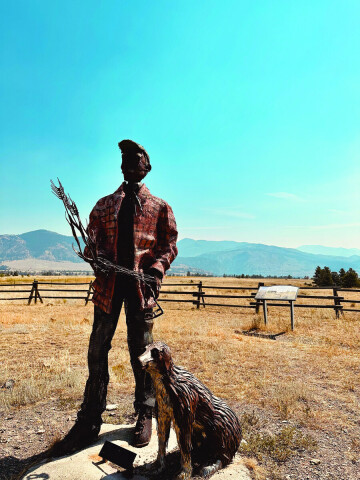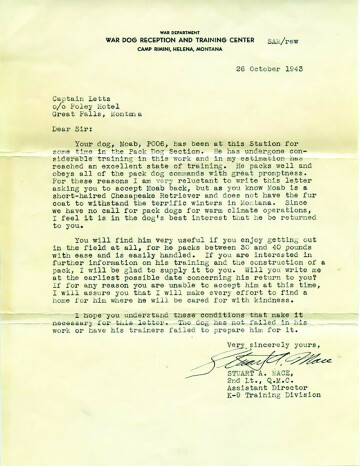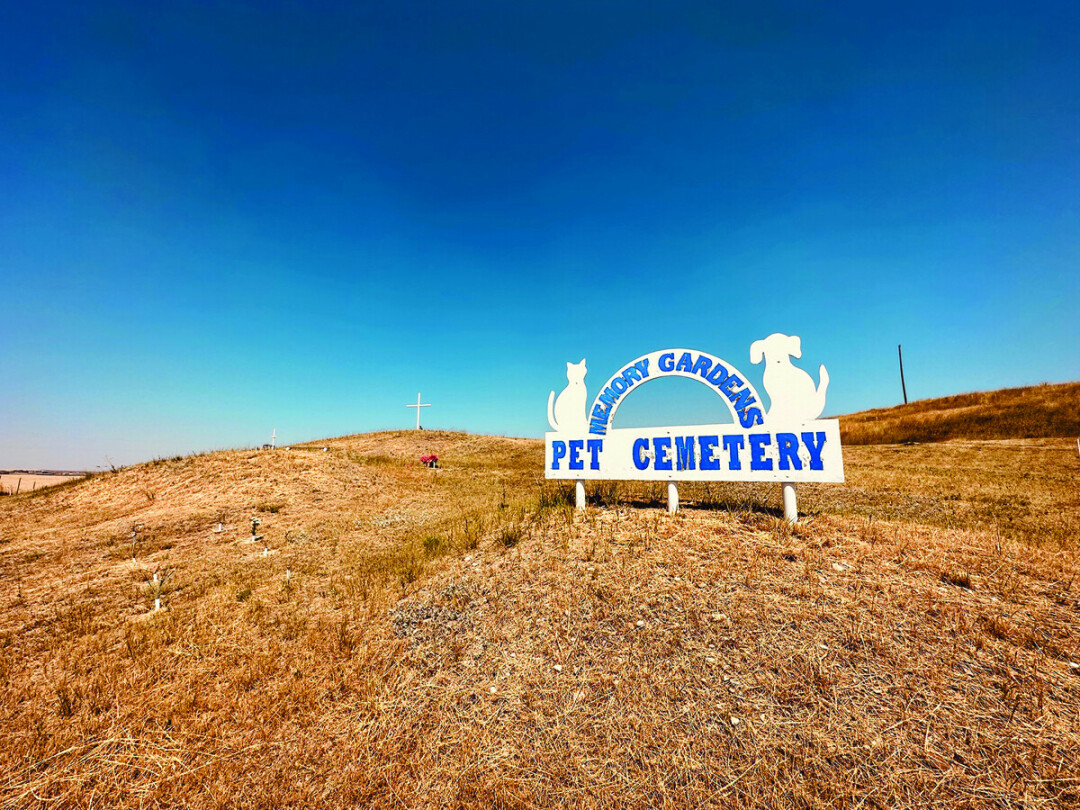Six Historically Significant Montana Pets
Liz Bischoff | Friday Sep. 1st, 2023

This short list of historically significant pets in Montana gives us a glimpse of Montanans’ relationships with their pets over the history of this amazing state. There is a common theme of love and companionship, which concludes that all dogs are truly legends in their masters’ eyes.
Seaman
Probably the most historically noteworthy canine in our history is that of Meriwether Lewis’s dog, Seaman, a burly black Newfoundland, purchased in 1803 in Pittsburg, Pennsylvania for $20 while Lewis waited to start the famous Lewis and Clark Expedition. He was most likely called Seaman because Newfoundlands typically accompanied fishermen and were skilled in the water, as well as on boats. He was the only animal to complete the entire voyage with his human companions. He was purchased specifically for his ability to swim and his likelihood of assisting in water rescues, should the need arise. He was known to police the camp, stand obediently by Lewis’s side, collect squirrels for his humans, and drive off buffalo when a herd neared the team. After being admired by an indigenous tribe for his good manners, he was reportedly stolen by another tribe. He was later returned, so it is unclear if these two tribes coincided. In the spring of 1805, Lewis and Clark performed surgery on Seaman’s hindleg artery after it was bitten by a beaver; thankfully, it saved his life. Seaman had explored the Pacific Ocean and crossed an entire continent. After his historic journey, his demise was due to heartbreak, when Meriwether Lewis died a premature death. Seaman refused meals and remained steadfastly at his master’s gravesite, ultimately dying of a broken heart shortly after Lewis died. A statue of Seaman can be found in Minot, North Dakota; he is also memorialized alongside Sacagawea, Lewis, and Clark, in the Lewis and Clark Interpretive Center in Great Falls, Montana.
Shep
Perhaps the most heartachingly beautiful story of loyalty is held by an Australian Shepherd mix, known locally as “The Railroad Dog.” He is monumentalized near the train station in Fort Benton, Montana because of his “forever faithfulness.” Shep’s owner was a sheepherder in the 1930’s and was sent to the Saint Claire Hospital in Fort Benton in 1936 where, sadly, he died shortly after his arrival. According to the nuns who worked at the hospital, Shep did not leave his master’s doorway during the shepherd’s short stay. When the nuns carefully wheeled and loaded the shepherd’s body out to the train to be returned to his family, Shep followed and watched. For six years after the fateful day, Shep loyally watched arriving travelers, hoping to see his master’s face again; of course, he never got the chance. Those arriving in Fort Benton often saw him as a nuisance, but locals would cherish his ongoing vigil. In six years of loyally patrolling the railroad, Shep had fallen deaf and did not hear an arriving train; the collision ultimately led to his death. Shep’s bronze statue cost the city approximately $75,000 to erect and is cared for by Boy Scout Troop 47. His story has lent itself to an ongoing donation to the Montana School for the Deaf and Blind in Great Falls, Montana, a fund that is still active today. Shep teaches us that the precious interactions we have with our dogs last a lifetime in our hearts. We can learn about patience and honor from Shep and his truly undying companionship to his owner.
Moab
A Chesapeake Bay Retriever, Moab was a part of the Camp Rimini War Dog Reception and Training Center, established at the base of McDonald Pass in Helena, Montana to organize and train “war dogs” in attempts to overthrow Nazi-occupied Norway. He was so cherished by Captains and trainers alike for being “intelligent,” “obedient,” and “having a good disposition” that, when the mission to invade Norway with the dogs was canceled, Moab was carefully transported back to the east due to the likelihood of not surviving the harsh Montana winters in his short-hair coat. It is unclear where Moab was sent after being released in October, 1943, though his “coworker” dogs were shipped to Alaska, Canada and Greenland for search and rescue missions.
Joker
This black spaniel is resting at the retired Great Falls, Montana Pet Cemetery (spanning from 1944-1988). The Pet Cemetery is the forever home to dogs and cats, as well as birds and rabbits, with a special division for dogs that served in WWII and were members of the K9 Corps. In October of 1944, Dr. Stanley C. Raye left his home and family in Montana for the Army Dental Corp and likely smuggled his dog, Joker, on the train with help from empathizing comrades. He was discovered, and Joker’s story was nationally publicized. Because of rules against bringing dogs which had been overseas back to the U.S., Joker was smuggled back to the United States with his master.
Sport
This famous springer spaniel was the inspiration behind logo art for the Garnier Cigar Company, as well as the name for their signature Sport Cigar. The Garnier Cigar Company, a Livingston, Montana company founded in 1886, was contracted by the Northern Pacific Railroad (the largest employer in Livingston before WWI) to sell cigars on their trains, which catapulted sales and manufacturing, and made G.C.C. the second largest employer at that time.
Gates of the Mountain Dog (unnamed)
Located at Gates of the Mountains outside of Helena, Montana is a sculpture called Montana Stockman with Dog, erected around 2005 by artist Jim Dolan. This wilderness area also has plaques honoring the history of ranching in the area, specifically by the Hilger Hereford Ranch and the Sieben Ranch. According to Dolan, this stockman depicts former Montana senator Max Sieben Baucus’s brother, though the Sieben family considers the sculpture to be a symbol of the work of ranchers in Montana as a whole, rather than a tribute to one particular rancher or stockman. From this sculpture we can gather that these two companions likely never separated. We can see the friendship between the two, and can easily imagine the dog herding the stockman’s sheep all day and sleeping by his feet all night. We can see shadows of the stockman scooping the dog’s chow and rubbing its head after a long day in the harsh Montana elements. If anyone has information about who this stockman might be or who the dog is, we would love to know!
Whether the dog is that of a famous expeditioner or a humble stockman, they always treat their masters as though they are kings of the world. You may only treat your dog with respect to reap the benefits of having a loyal and kind companion to accompany you on your travels. The dogs of Montana’s history were hardworking—docile at home but fiercely professional in the field, and they left their masters with everlasting memories of good friendship. If you have a Shep or a Moab at home, be sure to give him a kiss on the nose and a long walk today.
| Tweet |